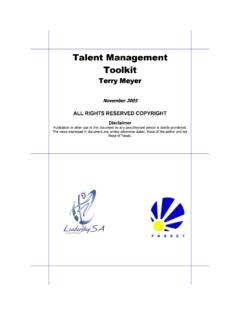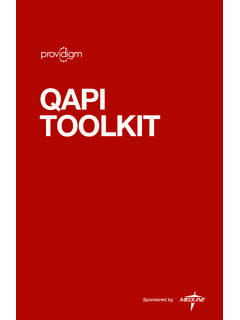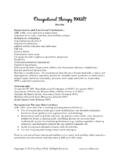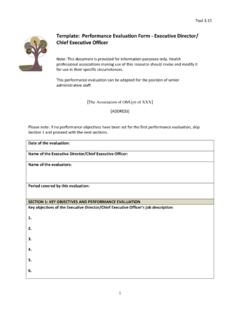Transcription of INSPECTORS TOOLKIT - Human factors in the …
1 Human factors TOOLKIT (DRAFT) HSE, October 2005 INSPECTORS TOOLKIT Human factors in the management of major accident hazards Introduction to Human factors hfhfHID Human factors TEAM Introduction to Human factors What we mean by Human factors Reducing error and influencing behaviour (HSG48) is the key document in understanding HSE s approach to Human factors . It gives a simple introduction to generic industry guidance on Human factors , which it defines as: Human factors refer to environmental, organisational and job factors , and Human and individual characteristics, which influence behaviour at work in a way which can affect health and safety This definition includes three interrelated aspects that must be considered: the job, the individual and the organisation: The job: including areas such as the nature of the task, workload, the working environment, the design of displays and controls, and the role of procedures.
2 Tasks should be designed in accordance with ergonomic principles to take account of both Human limitations and strengths. This includes matching the job to the physical and the mental strengths and limitations of people. Mental aspects would include perceptual, attentional and decision making requirements. The individual: including his/her competence, skills, personality, attitude, and risk perception. Individual characteristics influence behaviour in complex ways. Some characteristics such as personality are fixed; others such as skills and attitudes may be changed or enhanced. The organisation: including work patterns, the culture of the workplace, resources, communications, leadership and so on. Such factors are often overlooked during the design of jobs but have a significant influence on individual and group behaviour.
3 In other words, Human factors is concerned with what people are being asked to do (the task and its characteristics), who is doing it (the individual and their competence) and where they are working (the organisation and its attributes), all of which are influenced by the wider societal concern, both local and national. People are involved in the working system because of a number of strengths: for example, versatility in providing a link between a number of tasks, knowledge and judgement, ease of communicating with and eliciting a response. Hence, Human acts and omissions can play a role in the initiation, mitigation, escalation and recovery phases of an incident. Job: Task, workload, environment, display & controls, procedures .. Individual: Competence, skills, personality, attitudes, risk Organisation: Culture, leadership, resources, work patterns, communications .. Culture & working environment National, local & workplace cultures, social & community values.
4 Human factors interventions will not be effective if they consider these aspects in isolation. The scope of what we mean by Human factors includes organisational systems and is considerably broader than traditional views of Human factors /ergonomics. Human factors can, and should, be included within a good safety management system and so can be examined in a similar way to any other risk control system. Categorising Human failure It is important to remember that Human failures are not random; there are patterns to them. It is worth knowing about the different failure types because they have different causes and influencing factors and as a consequence the ways of preventing or reducing the failures are similarly different. There are three types of Human failures (unsafe acts) that may lead to major accidents: Unintentional errors: changing down into 3rd gear when you intended (correctly) to change up into 5th.
5 Errors (slips/lapses) are actions that were not as planned (unintended actions). These can occur during a familiar task omissions like forgetting to do something, which are particularly relevant to repair, maintenance, calibration or testing. These are unlikely to be eliminated by training and need to be designed out. Mistakes are also errors, but errors of judgement or decision-making ( intended actions are wrong ) - where we do the wrong thing believing it to be right. These can appear in situations where behaviour is based on remembered rules or familiar procedures or unfamiliar situations where decisions are formed from first principles and lead to misdiagnoses or miscalculations. Training is the key to avoiding mistakes. making a poor judgement when overtaking, leaving insufficient room to complete the manoeuvre in the face of oncoming traffic.
6 Intentional errors: Violations differ from the above in that they are intentional (but usually well-meaning) failures, such as taking a short-cut or non-compliance with procedures deliberate deviations from the rules or procedures. They are rarely wilful ( sabotage) and usually result from an intention to get the job done despite the consequences. Violations may be situational, routine, exceptional or malicious as outlined below. speeding when you are late for an appointment. Routine violations: a behaviour in opposition to a rule, procedure, or instruction that has become the normal way of behaving within the person s peer/work group. Exceptional violations: these violations are rare and happen only in unusual and particular circumstances, often when something goes wrong in unpredicted circumstances during an emergency situation. Situational violations: these violations occur as a result of factors dictated by the worker s immediate work space or environment (physical or organisational).
7 Acts of sabotage: these are self explanatory although the causes are complex - ranging from vandalism by a de-motivated employee to terrorism. There are several ways to manage violations, including taking steps to increase their detection, ensuring that rules and procedures are relevant/practical and explaining the rationale behind certain rules. Involving the workforce in drawing up rules increases their acceptance. Getting to the root cause of any violation is the key to understanding and hence preventing the violation. Unsafe acts Slips Lapses ViolationsMistakes Unintended actions (errors) Intended actions Memory failuresAttention failures Knowledge-based Routine Acts of sabotage Situational Rule-based Exceptional Plan of action satisfactory but action deviated from intention in some unintentional way Misapplication of good rule or application of a bad rule No ready-made solution, new situation tackled by thinking out answer from scratch Habitual deviation from regular practices Non-routine infringement dictated by extreme local circumstances Non-routine infringement dictated by local circumstances Figure 5: Types of Human error The likelihood of these Human failures is determined by the condition of a finite number of performing influencing factors , such as distraction, time pressure, workload, competence, morale, noise levels and communication systems.
8 Given that these factors influencing Human performance can be identified, assessed and managed, potential Human failures can also be predicted and managed. In short, Human failures are not random events. The key message here is that Human errors and rule breaking are largely predictable and therefore, can be identified and, most importantly, managed. We seek to encourage industry to tackle error reduction in a structured and proactive way, with as much rigour as the technical aspects of safety and make it an integrated part of their safety management system. Managing Human failures common pitfalls There is more to managing Human failure in complex systems than simply considering the actions of individual operators. However, there is obvious merit in managing the performance of the personnel who play an important role in preventing and controlling major incidents, as long as the context in which this behaviour occurs is also considered.
9 There are several mistakes that major hazard sites commonly make when assessing Human performance. These include: Treating operators as if they are superhuman, able to intervene heroically in emergencies, Providing precise probabilities of Human failure (usually indicating very low chance of failure) without documenting assumptions/data sources, Assuming that an operator will always be present, detect a problem and immediately take appropriate action, Assuming that people will always follow procedures, Stating that operators are well-trained, when it is not clear how the training provided relates to major accident hazard prevention or control and without understanding that training will not effect the prevention of slips/lapses or violations, only mistakes, Stating that operators are highly motivated and thus not prone to unintentional failures or deliberate violations, Ignoring the Human component completely, failing to discuss Human performance at all in risk assessments, leading to the impression that the site is unmanned, Inappropriate application of techniques, such as detailing every task on site and therefore losing sight of targeting resources where they will be most effective.
10 Producing grand motherhood statements that Human error is completely managed (without stating exactly how). Managing Human failures three serious concerns The misconceptions discussed above can be summarised into three areas of concern, where major hazard sites do not adequately address Human factors issues, which are: Concern 1: An imbalance between hardware and Human issues and focusing only on engineering ones, Concern 2: Focussing on the Human contribution to personal safety rather than to the initiation and control of major accident hazards and Concern 3: Focussing on operator error at the expense of system and management failures . Concern 1: hardware vs Human issues and the focus on engineering Despite the growing awareness of the significance of Human factors in safety, particularly major accident safety, the focus of many sites is almost exclusively on engineering and hardware aspects, at the expense of people issues.















